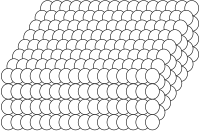
Photo from wikipedia
Abstract We studied the applicability of the Discrete Dipole Approximation (DDA) for scattering by partially melted snowflakes in the microwave region. The DDA accuracy in the case of a liquid… Click to show full abstract
Abstract We studied the applicability of the Discrete Dipole Approximation (DDA) for scattering by partially melted snowflakes in the microwave region. The DDA accuracy in the case of a liquid water coated ice sphere was tested at various particle sizes, water layer thicknesses, frequencies and DDA grid resolutions. We found that the backscattering and absorption cross section show the largest biases with respect to the Mie reference. The highest discrepancies were found for the thinnest water coating and the lowest frequency. We applied a previously published method to separately analyze the errors due to the representation of particle shape and discretization. The accuracy of the DDA seems to decrease particularly when only a single dipole is used to represent some structural element of the target with large refractive index. A similar behavior was also found by testing the variation of the scattering properties of complex shaped melting snowflakes at different grid resolutions. From both experiments we conclude that single isolated water dipoles should be avoided when modeling the scattering properties of melting snowflakes in the microwave using DDA. Although we found that a stability criterion which is commonly used for pure ice particles is not sufficient for melting particles, the DDA results in general converge to the exact Mie solution when shape and discretization errors are reduced by using a refined grid.
Journal Title: Journal of Quantitative Spectroscopy and Radiative Transfer
Year Published: 2018
Link to full text (if available)
Share on Social Media: Sign Up to like & get
recommendations!